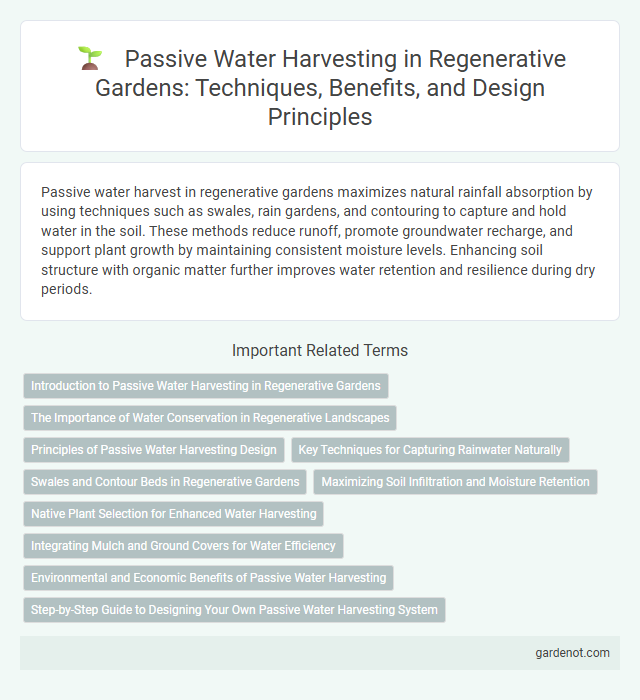Passive water harvest in regenerative gardens maximizes natural rainfall absorption by using techniques such as swales, rain gardens, and contouring to capture and hold water in the soil. These methods reduce runoff, promote groundwater recharge, and support plant growth by maintaining consistent moisture levels. Enhancing soil structure with organic matter further improves water retention and resilience during dry periods.
Introduction to Passive Water Harvesting in Regenerative Gardens
Passive water harvesting in regenerative gardens captures and utilizes rainfall through landscape design techniques such as swales, berms, and contour trenches to maximize soil moisture retention. These methods reduce irrigation needs by directing water to plant roots and promoting groundwater recharge, enhancing ecosystem resilience in dry climates. Implementing passive water harvesting supports sustainable garden management by minimizing water waste and improving plant health naturally.
The Importance of Water Conservation in Regenerative Landscapes
Passive water harvest in regenerative gardens maximizes water retention by capturing rainfall through swales, rain gardens, and permeable surfaces, reducing irrigation needs and preventing soil erosion. Efficient water conservation supports plant health, enhances biodiversity, and strengthens ecosystem resilience by maintaining natural hydrological cycles. Harnessing these techniques is critical for sustainable landscape management and mitigating climate change impacts.
Principles of Passive Water Harvesting Design
Passive water harvesting design relies on principles such as contouring land to slow runoff, using swales and berms to capture and infiltrate water, and selecting appropriate soil types that enhance moisture retention. Integrating vegetation patterns that maximize shade and reduce evaporation plays a critical role in sustaining soil moisture. Designs emphasize minimizing soil disturbance and promoting natural water cycles to improve drought resilience in regenerative gardens.
Key Techniques for Capturing Rainwater Naturally
Key techniques for passive water harvest in regenerative gardens include swales, which are shallow, contour-aligned trenches that capture and slowly infiltrate rainwater into the soil, reducing erosion and promoting groundwater recharge. Rain gardens utilize native plants in depressions to absorb and filter runoff, enhancing water retention and biodiversity. Bioswales combine vegetated channels with engineered soil to direct and cleanse stormwater while maximizing infiltration and supporting plant growth.
Swales and Contour Beds in Regenerative Gardens
Swales and contour beds are key techniques for passive water harvesting in regenerative gardens, designed to capture and infiltrate rainfall efficiently along landscape contours. These earthworks reduce erosion, increase soil moisture retention, and promote groundwater recharge by slowing runoff and directing water to planted areas. Implementing swales and contour beds enhances ecosystem resilience and supports sustainable plant growth in regenerative landscaping.
Maximizing Soil Infiltration and Moisture Retention
Maximizing soil infiltration and moisture retention through passive water harvesting techniques enhances the health and productivity of regenerative gardens. Incorporating swales, berms, and contour trenches slows runoff, allowing water to percolate deeply into the soil profile, which supports robust root growth. Applying organic mulch and biochar improves soil structure and water-holding capacity, reducing evaporation and sustaining moisture during dry periods.
Native Plant Selection for Enhanced Water Harvesting
Selecting native plants with deep root systems enhances passive water harvesting by maximizing soil infiltration and moisture retention in regenerative gardens. These plants are adapted to local climate conditions, reducing irrigation needs and promoting sustainable water cycles. Their compatibility with native soil and rainfall patterns optimizes groundwater recharge and minimizes surface runoff.
Integrating Mulch and Ground Covers for Water Efficiency
Integrating mulch and ground covers in regenerative gardens significantly enhances passive water harvesting by reducing surface evaporation and improving soil moisture retention. Organic mulch materials, such as straw or wood chips, create a protective layer that minimizes water runoff and promotes gradual infiltration into the soil. Ground covers like clover, creeping thyme, or native grasses reduce soil temperature and prevent erosion, further optimizing water efficiency in sustainable landscaping systems.
Environmental and Economic Benefits of Passive Water Harvesting
Passive water harvesting enhances environmental sustainability by reducing soil erosion, replenishing groundwater, and promoting biodiversity through natural water infiltration. Economically, it lowers irrigation costs and decreases dependence on municipal water supplies, making garden maintenance more affordable. This method also improves plant health and growth, which can increase crop yields and long-term agricultural productivity.
Step-by-Step Guide to Designing Your Own Passive Water Harvesting System
Designing a passive water harvesting system begins with analyzing your garden's topography to identify natural water flow patterns and low-lying collection points. Incorporate features such as swales, contour trenches, and berms to slow and capture runoff, directing water toward planting zones or storage areas. Use permeable materials and native plants to enhance infiltration and reduce evaporation, maximizing water retention and promoting sustainable garden hydration.
Passive water harvest Infographic

 gardenot.com
gardenot.com